In this article:
Snacking can be difficult when you have diabetes. Every time you eat or drink, you are at risk of developing high blood sugar, and that can be frustrating!
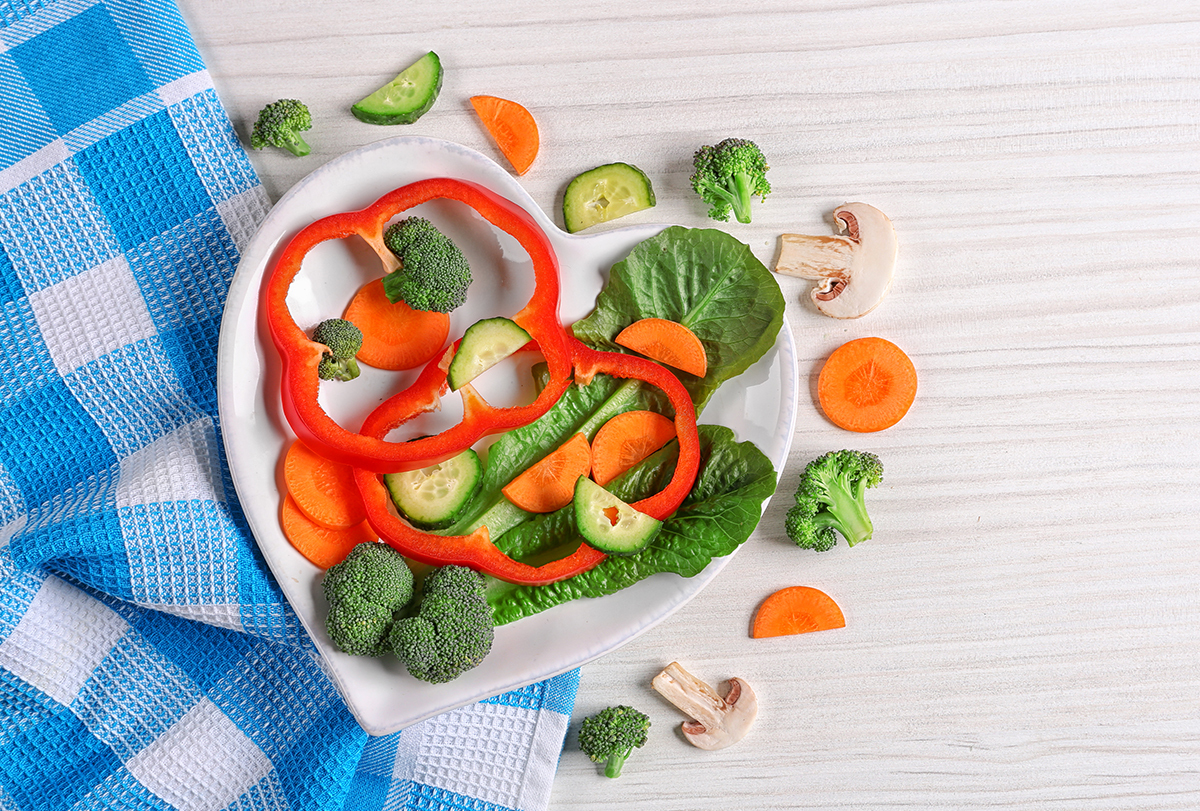
Snacking can serve several purposes. You might need something to hold you over between meals, to refuel post-workout, to prevent a low blood sugar reading, or to help you get more nutrients in your diet.
Whatever the case may be, planning ahead and having some healthy snacks prepared can help you to stabilize your blood sugar level and prevent any unwanted highs or lows from happening throughout the day.
Keep reading to learn how to pair foods together to slow the release of sugar in your bloodstream and to keep your blood sugar level in the normal range.
Eating a well-balanced diet is critical for keeping blood sugars in check. When you have diabetes, your body is not able to use insulin efficiently (type 2 diabetes), or it does not make any insulin at all (type 1 diabetes).
Insulin is a hormone made in the pancreas that helps transport sugar digested from carbohydrates (carbs) to the cells of the body for energy purposes.
When the body does not have enough working insulin, the excess sugar consumed in the diet is released in the blood with nowhere to go. It stays there until you either take an injection of insulin, exercise, go without carbs for an extended period, or take oral prescription medications.
Recommended Snacks for People With Diabetes
The following are my top 10 balanced snack recommendations for diabetics. All of these snacks are high-fiber carbs + protein + healthy fat.
1. Chia seed pudding
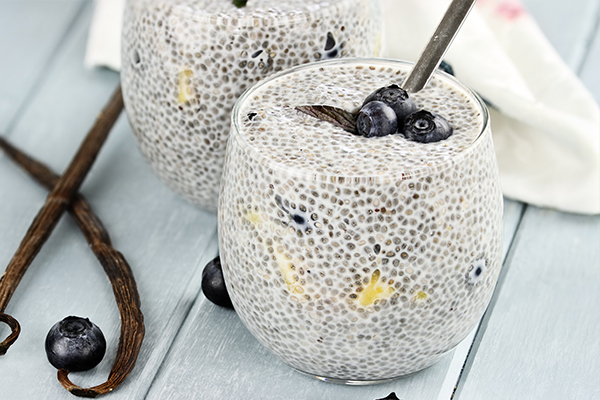
Chia seed pudding, or simply, chia pudding, is made by mixing whole chia seeds in milk and allowing the mixture to soak until it forms a pudding-like consistency.
Chia seeds are packed with fiber and healthy omega-3 fats and are good sources of zinc and calcium. (4) You can also add a tablespoon of chia seeds to oatmeal, yogurt, and smoothies for added nutrients.
Note: Never eat chia seeds dry since they swell up and can block your esophagus. Mix them with a liquid or add them to dishes.
Recipe
Yields 1 serving
Ingredients:
- ¼ cup chia seeds
- 1 cup unsweetened almond or soy milk
- ½ cup fresh berries
Instructions:
- Mix ¼ cup chia seeds and 1 cup unsweetened almond or soy milk in a Mason jar or container with a lid.
- Refrigerate for at least 2 hours or overnight.
- Top with ½ cup fresh berries for extra fiber, vitamins, and antioxidants.
Did you know?
Using unsweetened plant-based milk adds only 0–3 grams of carbs, whereas cow’s milk adds 8 grams of carbs per 1 cup serving.
2. No-bake energy balls with cinnamon
Made from high-fiber oatmeal, peanut butter, crushed walnuts, and banana, these bars have about 12 grams of carbs and 4 grams of protein per ball. They have no added sugar.
Walnuts are another great source of healthy omega-3 fats that help reduce inflammation and protect the heart. (5)
Recipe
Yields 20–24 energy balls
Ingredients:
Instructions:
- Combine oats, peanut butter, crushed walnuts, and honey in the bowl of a stand mixer fitted with the paddle attachment.
- Beat until well combined, adding more honey if the mixture is not holding together.
- Using a cookie scoop, form 20–24 balls and place them on a cookie sheet.
- Dust with coconut and/or cocoa powder.
- Refrigerate for 30–60 minutes or until firm.
3. Fresh fruit and nuts or nut butter
Slice a small or medium apple or pear and spread a tablespoon of natural nut butter over the fruit slices. This snack is quick and simple but a great option when you’re running low on time! If you’re on the go, a handful of nuts instead of nut butter works too.
4. Celery sticks and nut butter
Celery sticks are a great low-carb, high-fiber snack. Pair 4–5 of them with 1–2 tablespoons of nut butter, and you have a great low-carb option for when you need to snack on something between meals but don’t necessarily need a boost in blood sugar.
If you don’t like celery sticks, try a few slices of jicama instead.
5. Edamame (soybeans)
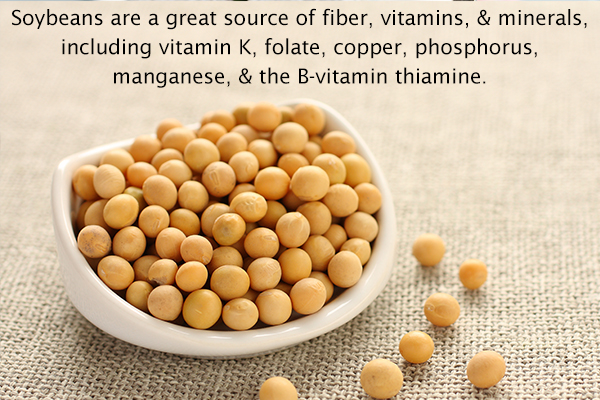
Soybeans are a type of legume from Asia. They have a natural combination of both carbs and plant-based protein. One cup of shelled soybeans (without the shell) contains about 14 grams of carbs and 30 grams of protein!
Soybeans are great sources of fiber, vitamins, and minerals, including vitamin K, folate, copper, phosphorus, manganese, and the B-vitamin thiamine.
They also contain isoflavones, a type of polyphenol that acts as an antioxidant, which has been shown to reduce inflammation and protect against cardiovascular disease, certain types of cancer, and osteoporosis. (6)
ALSO READ: Soy: Nutrients, Health Benefits and Allergy Symptoms
6. Popcorn
One serving of popcorn is 3 cups popped! That’s a much better alternative to something like potato chips, which have a serving of about 10 chips and are often fried in unhealthy oils and high in sodium.
I recommend making your own popcorn at home with organic corn kernels by using a covered pan and a small amount of avocado oil or by using an air popper.
You can also have store-bought popcorn that’s low in salt (<140 mg/servings) with no added butter or sugar. Skip the kettle corn popcorn or the candy-covered one, which has both added fat and sugar.
If you like cheesy popcorn, add 1–2 tablespoons of nutritional yeast to your next bag/batch for a boost of protein and B vitamins without the added fat or salt.
7. A slice of whole-wheat toast with avocado
Not all sliced bread is created equal. Make sure the first ingredient on the label of wheat bread you buy is whole-wheat flour and that each slice contains at least 3 grams of fiber and no more than 20 grams of carbs.
Adding avocado to your toast instead of butter provides some added healthy fat, fiber, antioxidants, and delicious flavor! Squeeze some fresh lemon or lime juice and sprinkle your favorite low-sodium seasoning on top.
8. A slice of whole-wheat toast and nut butter
Choose whole-wheat bread and nut butter with no added sugar or fat. The best natural nut butters have just 1–2 ingredients – for example, peanuts, or peanuts, and salt.
Some nut butters might seem healthy from the front of the label but have hidden added sugars and trans fat (hydrogenated oils) that can worsen your blood sugar level and increase your risk of heart disease.
9. Sliced low-carb veggies and hummus
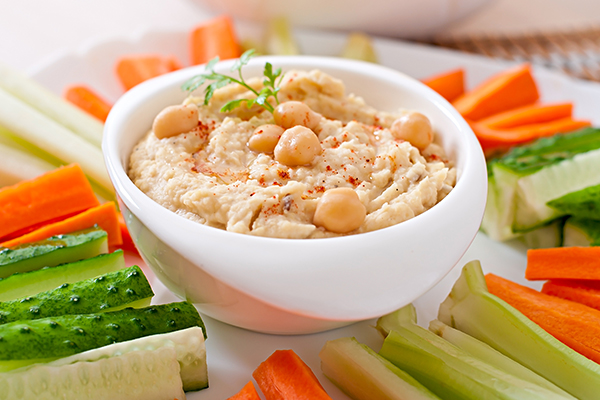
Low-carb veggies are always a healthy option. Some great choices are carrots, celery, cherry tomatoes, broccoli, cauliflower, sugar snap peas, and jicama. You can buy some pre-cut veggies or a veggie platter, but instead of the ranch dressing, use high fiber-hummus as your dip.
Having low-carb veggies without the hummus is a great option if you’re hungry between meals, and you have a high blood sugar level, or you don’t want to have to take any more insulin.
10. Unsweetened Greek yogurt with berries
Greek yogurt provides gut-healthy probiotics and a good amount of protein. A single-serve yogurt cup (5.3 oz) contains 14 grams of protein and only 6 grams of carbs.
Be sure to buy unsweetened yogurt since some flavored yogurt contains as much as 20 grams of added sugar per serving (that’s 5 teaspoons of sugar!).
It’s best to skip the brands with artificial sweeteners as well. Sweeten yogurt with a handful of berries, which also provide filling fiber and inflammation-fighting antioxidants. (7)
Criteria for a Diabetes-Friendly Snack
Just like with meals, pairing high fiber carbs with a source of protein and healthy fat makes for an optimal snack. These are some important health snacking points that people with diabetes must remember:
- Fiber, protein, and fat all slow digestion, and therefore, sugar from foods with these nutrients will not be released into the bloodstream quickly. A slow release of sugar means your blood sugar will not spike, and getting your sugar back down after you eat will not be hard.
- Consuming snacks with high-fat content, especially fat from animal products, can cause a delayed spike in blood sugar, which is more difficult to control. Examples of these foods are fried foods, pizza, high-fat beef burgers, sausage, pepperoni, and other high-fat meats.
- Portion control and overall calories are also important when it comes to healthy eating. The average adult with diabetes will need 5–20 grams of carbs per serving, depending on their needs. (3)
The Harmful Effects of High Blood Sugar
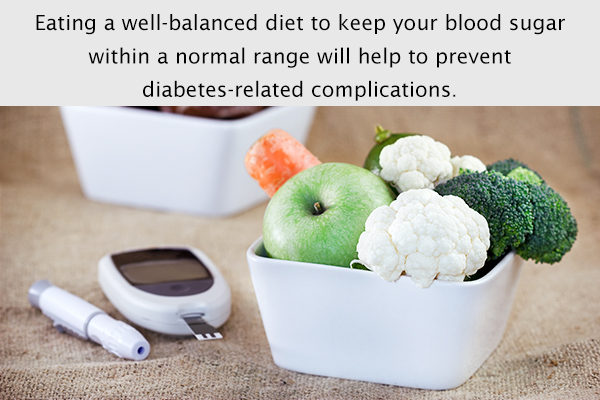
Think of sugar in the blood as a bunch of spiky balls swimming through the bloodstream. The higher and longer your blood sugar remains elevated, the more damage those spikes are doing to your blood vessels.
Over time, damage to vessels of the eyes, kidneys, heart, nerves, and brain occurs. Therefore, eating a well-balanced diet to keep your blood sugar within a normal range will help to prevent diabetes-related complications. (1)
Since people with diabetes are at greater risk of developing heart disease, they also need to be mindful of the amount of salt and type of fats they consume. (2)
Healthy Snacking Tips for People With Diabetes
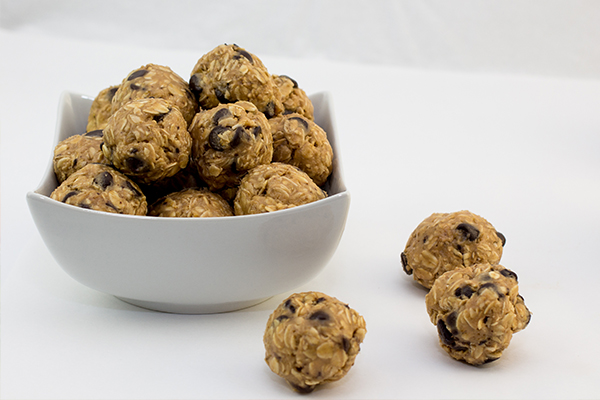
If you’re feeling hungry and your blood sugar is still high from a previous meal, stress, or illness, it might be safer to consume a snack low in carbs, so you’re not further contributing to the amount of sugar in the blood.
If you’ve been told to take insulin or medication with food, make sure you’re counting carbs appropriately, taking the right amount of insulin as recommended by your doctor, and timing it appropriately.
Food affects everyone differently. What works for someone else might not work for you. It often takes some trial and error.
Final Word
Balanced snacking is important to prevent high and low blood sugars when you have diabetes. However, when treating a low blood sugar less than 70 mg/dL, it’s best to avoid any added protein and fat since this will slow digestion and take longer for your blood sugar level to return to the target range (at least above 70 mg/dL). (8)
The best low blood sugar treatment options are chewable glucose tablets, glucose gels, sugary candies, and drinks approved by your healthcare provider. In severe cases, a glucagon kit is needed. For some people, symptoms of low blood sugar can begin at much higher numbers if they’re used to their blood sugar being elevated.
If you’re frequently having symptoms of low blood sugar when it’s higher than 70 on your blood sugar meter, it’s a good idea to check to make sure your meter is working properly by using the control solution that comes with a new box of test strips or compare it to another meter.
Discuss these symptoms and results with your doctor, Registered Dietitian, or Diabetes Educator.
- Was this article helpful?
- YES, THANKS!NOT REALLY


